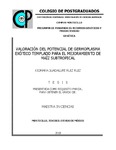| dc.contributor.author | Ruiz Ruiz, Xiomara Guadalupe | |
| dc.creator | RUIZ RUIZ, XIOMARA GUADALUPE; 788824 | |
| dc.date.accessioned | 2018-10-29T17:53:04Z | |
| dc.date.available | 2018-10-29T17:53:04Z | |
| dc.date.issued | 2018-10 | |
| dc.identifier.uri | http://hdl.handle.net/10521/3055 | |
| dc.description | Tesis (Maestría en Ciencias, especialista en Genética).- Colegio de Postgraduados, 2018. | es_MX |
| dc.description.abstract | El germoplasma de maíz (Zea Mays L.) en el subtrópico presenta algunas desventajas agronómicas como bajo potencial de rendimiento, madurez tardía y acame. El objetivo fue valorar el potencial de la incorporación del germoplasma templado de la Faja Maicera al maíz subtropical en México para su mejoramiento. A partir de seis poblaciones de cada grupo heterótico “A” y “B” con 25% de germoplasma exótico, se derivaron líneas S3 con el método de pedigrí. Cada grupo de líneas se cruzó con un probador de grupo contrario para formar mestizos y se evaluaron en seis localidades en el subtrópico durante el ciclo primavera - verano de 2017. Para el grupo heterótico “B” la tercera parte de los mestizos superaron a los testigos subtropicales en más de una t ha-1, seis mestizos superaron en rendimiento al testigo comercial Dekalb 2061 con 0.02 a 0.70 t ha-1. El promedio de los mestizos de la población CML444/LH213//CL106951 de grupo heterótico “B”, resultó sobresaliente en este estudio con un rendimiento de 11.4 t ha-1 y con un porte de altura hasta 7 cm menor que el testigo comercial Dekalb 2061. Los mestizos de las poblaciones del grupo heterótico “A” en promedio fueron inestables con los ambientes y se obtuvo un menor potencial de rendimiento, de aquí sólo seis mestizos fueron superiores a los testigos subtropicales derivados de la población CML264/PHHB9//CML549. En general, las seis poblaciones y sus mestizos presentaron buen comportamiento agronómico, ciclo de madurez intermedio y no hubo presencia grave de enfermedades. El germoplasma exótico templado de la faja maicera en proporción de 25 % se adapta bien a las condiciones de subtrópico y aporta características agrónomicas útiles para mejoramiento genético del maíz subtropical. _______________ AN ASSESSMENT OF THE POTENTIAL TEMPERATE EX-PVP GERMPLASM TO IMPROVE THE YIELD POTENTIAL OF SUBTROPICAL MAIZE. ABSTRACT: Subtropical maize germplasm (Zea Mays L.) presents some agronomic disadvantages such as low yield potential, late maturity and susceptibility to lodging. The objective was to evaluate the potential incorporation the temperate germplasm of the Corn Belt from EEUU to the subtropical corn from Mexico for its improvement. Three populations of each heterotic pattern "A" and "B" with 25 % of exotic germplasm, lines were derived to S3 with the pedigree method. Each group of lines was crossed with an opposite group of testers to form the testcrosses and were evaluated in six environments in the subtropics during the cycle 2017. For the heterotic pattern "B" the third part of the testcrosses exceeded the subtropical checks to more than one ton/ha, six testcrosses exceeded in performance the commercial check Dekalb 2061 by 0.02 to 0.70 t ha-1. The average from the testcrosses of the population CML444/LH213//CL106951 from heterotic pattern "B", was outstanding in this study with a yield of 11.4 t ha-1 and with a height of up to 7 cm lower than the commercial check Dekalb 2061. The average from the testcrosses of the populations from heterotic pattern "A" were unstable with the environment and obtained a lower yield potential, from these only six testcrosses were outstanding to the subtropical checks derived from the population CML264/PHHB9//CML549. In general, the six populations and their testcrosses presented a good agronomic performance, intermediate cycle of maturity and there was no serious presence of diseases. The exotic temperate germplasm of the corn belt in proportion of 25 % adapts well to subtropical conditions, it can provide useful agronomic characteristics for genetic improvement of subtropical corn. | es_MX |
| dc.description.sponsorship | Consejo Nacional de Ciencia y Tecnología (CONACyT). | es_MX |
| dc.format | pdf | es_MX |
| dc.language.iso | spa | es_MX |
| dc.rights.uri | http://creativecommons.org/licenses/by-nc-nd/4.0 | es_MX |
| dc.subject | Zea Mays L. | es_MX |
| dc.subject | Germoplasma exótico | es_MX |
| dc.subject | Mejoramiento genético | es_MX |
| dc.subject | Mestizo | es_MX |
| dc.subject | Subtrópico | es_MX |
| dc.subject | Exotic germplasm | es_MX |
| dc.subject | Genetic breeding | es_MX |
| dc.subject | Testcross | es_MX |
| dc.subject | Subtropics | es_MX |
| dc.subject | Genética | es_MX |
| dc.subject | Maestría | es_MX |
| dc.subject.classification | CIENCIAS AGROPECUARIAS Y BIOTECNOLOGÍA::CIENCIAS AGRARIAS::AGRONOMÍA::GENÉTICA VEGETAL | es_MX |
| dc.title | Valoración del potencial de germoplasma exótico templado para el mejoramiento de maíz subtropical. | es_MX |
| dc.type | Tesis | es_MX |
| Tesis.contributor.advisor | Castillo González, Fernando | |
| Tesis.contributor.advisor | Santacruz Varela, Amalio | |
| Tesis.contributor.advisor | Dhliwayo, Thanda | |
| Tesis.date.submitted | 2018 | |
| Tesis.date.accesioned | 2018 | |
| Tesis.date.available | 2018 | |
| Tesis.format.mimetype | pdf | es_MX |
| Tesis.format.extent | 1,432 KB | es_MX |
| Tesis.subject.nal | Heterosis | es_MX |
| Tesis.subject.nal | Floración | es_MX |
| Tesis.subject.nal | Flowering | es_MX |
| Tesis.rights | Acceso abierto | es_MX |
| Articulos.subject.classification | Maíz | es_MX |
| dc.type.conacyt | masterThesis | es_MX |
| dc.identificator | 6||31||3103||241714 | es_MX |
| dc.contributor.director | CASTILLO GONZALEZ, FERNANDO; 7304 | |
| dc.audience | generalPublic | es_MX |


